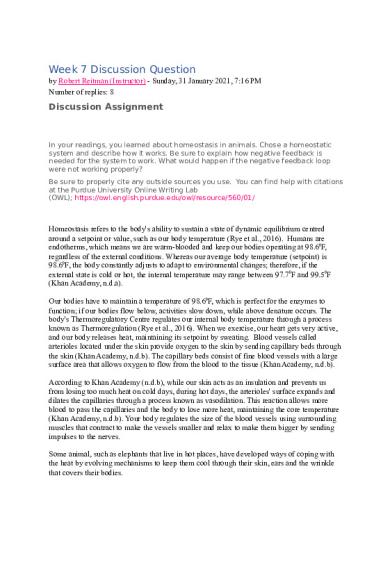Week 7 Discussion Question PDF

| Title | Week 7 Discussion Question |
|---|---|
| Course | Biology 2 for Health Studies Majors |
| Institution | University of the People |
| Pages | 2 |
| File Size | 88 KB |
| File Type | |
| Total Downloads | 52 |
| Total Views | 176 |
Summary
Week 7 Discussion Question...
Description
Week 7 Discussion Question by Robert Reitman (Instructor) - Sunday, 31 January 2021, 7:16 PM Number of replies: 8
Discussion Assignment
In your readings, you learned about homeostasis in animals. Chose a homeostatic system and describe how it works. Be sure to explain how negative feedback is needed for the system to work. What would happen if the negative feedback loop were not working properly? Be sure to properly cite any outside sources you use. You can find help with citations at the Purdue University Online Writing Lab (OWL); https://owl.english.purdue.edu/owl/resource/560/01/
Homeostasis refers to the body's ability to sustain a state of dynamic equilibrium centred around a setpoint or value, such as our body temperature (Rye et al., 2016). Humans are endotherms, which means we are warm-blooded and keep our bodies operating at 98.60F, regardless of the external conditions. Whereas our average body temperature (setpoint) is 98.60F, the body constantly adjusts to adapt to environmental changes; therefore, if the external state is cold or hot, the internal temperature may range between 97.70F and 99.50F (Khan Academy, n.d.a). Our bodies have to maintain a temperature of 98.60F, which is perfect for the enzymes to function; if our bodies flow below, activities slow down, while above denature occurs. The body's Thermoregulatory Centre regulates our internal body temperature through a process known as Thermoregulation (Rye et al., 2016). When we exercise, our heart gets very active, and our body releases heat, maintaining its setpoint by sweating. Blood vessels called arterioles located under the skin provide oxygen to the skin by sending capillary beds through the skin (Khan Academy, n.d.b). The capillary beds consist of fine blood vessels with a large surface area that allows oxygen to flow from the blood to the tissue (Khan Academy, n.d.b). According to Khan Academy (n.d.b), while our skin acts as an insulation and prevents us from losing too much heat on cold days, during hot days, the arterioles' surface expands and dilates the capillaries through a process known as vasodilation. This reaction allows more blood to pass the capillaries and the body to lose more heat, maintaining the core temperature (Khan Academy, n.d.b). Your body regulates the size of the blood vessels using surrounding muscles that contract to make the vessels smaller and relax to make them bigger by sending impulses to the nerves. Some animal, such as elephants that live in hot places, have developed ways of coping with the heat by evolving mechanisms to keep them cool through their skin, ears and the wrinkle that covers their bodies.
Reference Khan Academy. (n.d.a). Homeostasis. Khan Academy. https://www.khanacademy.org/science/high-school-biology/hs-human-body-systems/hsbody-structure-and-homeostasis/a/homeostasis Khan Academy. (n.d.b). Thermoregulation in the circulatory system. Khan Academy. https://www.khanacademy.org/test-prep/mcat/organ-systems/the-circulatorysystem/v/thermoregulation-in-the-circulatory-system Rye, C., Wise, R., Jurukivski, V., DeSaix, J., Choi, J., & Avissar, Y. (2016). Biology. OpenStax. https://openstax.org/books/biology/pages/1-introduction...
Similar Free PDFs

Week 7 Discussion Question
- 2 Pages

Week 7 Tutorial Question
- 4 Pages

Week 7 discussion
- 1 Pages

Discussion Week 7
- 2 Pages

Week 7 Discussion Board
- 1 Pages

Bonds discussion forum week 7
- 2 Pages

NR 603 week 7 discussion
- 4 Pages

discussion question
- 1 Pages

Discussion Question
- 1 Pages
Popular Institutions
- Tinajero National High School - Annex
- Politeknik Caltex Riau
- Yokohama City University
- SGT University
- University of Al-Qadisiyah
- Divine Word College of Vigan
- Techniek College Rotterdam
- Universidade de Santiago
- Universiti Teknologi MARA Cawangan Johor Kampus Pasir Gudang
- Poltekkes Kemenkes Yogyakarta
- Baguio City National High School
- Colegio san marcos
- preparatoria uno
- Centro de Bachillerato Tecnológico Industrial y de Servicios No. 107
- Dalian Maritime University
- Quang Trung Secondary School
- Colegio Tecnológico en Informática
- Corporación Regional de Educación Superior
- Grupo CEDVA
- Dar Al Uloom University
- Centro de Estudios Preuniversitarios de la Universidad Nacional de Ingeniería
- 上智大学
- Aakash International School, Nuna Majara
- San Felipe Neri Catholic School
- Kang Chiao International School - New Taipei City
- Misamis Occidental National High School
- Institución Educativa Escuela Normal Juan Ladrilleros
- Kolehiyo ng Pantukan
- Batanes State College
- Instituto Continental
- Sekolah Menengah Kejuruan Kesehatan Kaltara (Tarakan)
- Colegio de La Inmaculada Concepcion - Cebu






